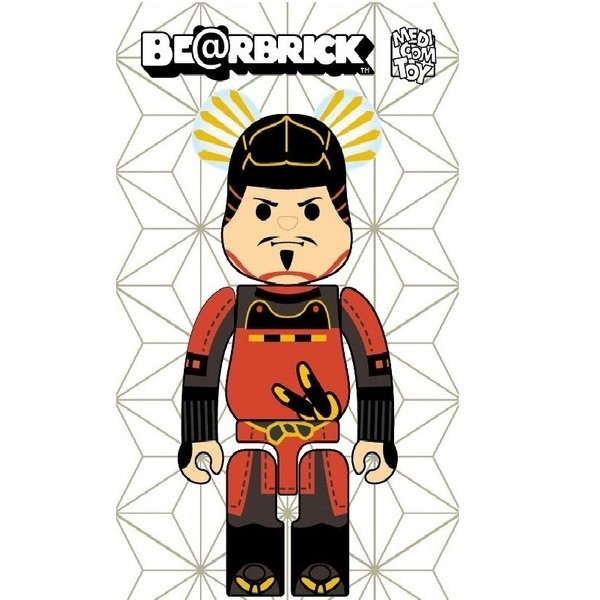 Toyotomi Hideyoshi Samurai Warrior - BE@RBRICK
Toyotomi Hideyoshi Samurai Warrior - BE@RBRICK
The end of the Sengoku Period served as a turning point in Japanese history. A newly unified Japan was now under one ruling government in an era of peace that would last over 200 years. Of the Great Unifiers, Toyotomi Hideyoshi conquered the most landmass and created systems that would enable stability. Medicom Toy honors the Great Unifier in the "Samurai Warrior BE@RBRICK Toyotomi Hideyoshi" figure in part of a series depicting Japanese Historical figures.
Samurai Warrior and BE@RBRICK Collaboration Background
Called the "Sengoku Samurai" line in Japan, BE@BRICK’s three-part Samurai Warrior launch took place during 2017.
Collaboration Planning and Launch
Medicom Toy's first Sengoku era-inspired figure came out in 2013. It was a solo launch depicting the famous Northeastern Japanese samurai Masamune Date. Inspired by the popularity of other historically inspired figures, Medicom Toy announced a six-figure Sengoku Samurai set in late 2016. In January 2017, Medicom Toy released the set's first pair, Sanada Yukimura and Oda Nobunaga. March saw the release of Uesugi Kenshin and Toyotomi Hideyoshi followed by Takeda Shingen and Tokugawa Ieyasu in May. Later that year, Medicom Toy released another six-figure BE@RBRICK set inspired by Japanese history, the Bakumatsu Era.
Samurai Warrior BE@RBRICK Toyotomi Hideyoshi
This historical BE@RBRICK figure from Medicom Toy pays homage to one of Japan's Great Unifiers, Toyotomi Hideyoshi. The figure depicts Hideyoshi wearing his famous red armor. The iconic gold ornamentation on his helmet can be seen on the figure's ears. Metallic gold bands fan outward like rays of light while the ear's gray background fades away. Two sword handles can be seen at the figure's hips, denoting the dual sword custom of samurai that Hideyoshi would reinforce. On the back, the figure displays the Toyotomi clan emblem in bright metallic gold paint.
- Product Name: Samurai Warrior BE@RBRICK Toyotomi Hideyoshi
- Series: Samurai Warrior BE@RBRICK
- Manufacturer: Medicom Toy
- Specifications: Painted & articulated plastic figure
- Height (Approx.): 70mm | 2.8"

Toyotomi Hideyoshi Background
Toyotomi Hideyoshi was a samurai during the late Sengoku period in Japanese history. He is referred to as the second of the "Three Great Unifiers of Japan."
Toyotomi Hideyoshi Background: Biography
Though little of his early life is known, most historians hold that Hideyoshi was born in Nakamura, Owari Province. Born to a peasant family, he had no traceable samurai lineage at birth. In 1558, Hideyoshi began serving the Oda clan as an ashigari, a foot soldier employed by samurai. He served the powerful Oda Nobunaga directly as his sandal-bearer, a highly important position. In 1564 Hideyoshi first employed his negotiation skills to convince warriors to desert the opposing Saito clan. After the Siege of Inabayama Castle in 1567, Hideyoshi rose to prominence as one of Nobunaga's most trusted generals. Nobunaga's assassination in 1582 propelled Hideyoshi to power after defeating his killer, Akechi Mitsuhide.
By 1583, Hideyoshi was in a powerful enough position to help choose Nobunaga's successor. He spent most of the next eight years developing the land surveying system that would help unify Japan. He is credited with influencing much of Japanese social and material class culture in the late pre-modern period. Hideyoshi has appeared in pop culture media around the world, including Mexican films and Korean television. Though not as popular as his one-time master, Nobunaga, Hideyoshi has been remembered for his ruthlessness and love of tea ceremony.
Toyotomi Hideyoshi: Career Highlights
Hideyoshi's greatest contribution to the late Sengoku period was through implementing land surveys and census counts. After registering each household in an area, Hideyoshi ordered that all citizens stay in their registered area until permitted otherwise. This served as the basis for a national tax system later. Additionally, Hideyoshi outlined the rigid class system that would dominate Japan for 300 years. Despite his own origins, he banned peasants from taking up weapons and joining the warrior class. Conversely, samurai would be confined to castle towns, limiting movement that could cause political instability.
Hideyoshi led numerous military campaigns that proved crucial for the unification of Japan. Notably, he suppressed opposition in historically unruly Kyushu and eliminated the threat of the powerful Hojo clan in Kanto. Though they did not get along, Hideyoshi often negotiated territorial claims and tentative alliances with Tokugawa Ieyasu. He and Ieyasu joined forces to stop the 1591 Kunohe Rebellion in Tohoku, completing the unification of Japan.
At the end of his career, Hideyoshi shifted his focus to conquering land overseas. He began a military campaign in Korea in 1592. After four months, Hideyoshi's forces occupied most of the Korean peninsula and began pursuing Manchuria. The Wanli Emperor of Ming China launched a counterattack to prevent a Japanese invasion of China. Hideyoshi renewed efforts to invade Korea in 1598 but faced similar opposition from China. He died that year after withdrawing his troops again, not wanting his men to die in a foreign land.
Related Figures
Japanese history fans can also collect the "Samurai Warrior BE@RBRICK Uesugi Kenshin." Released as a pair with Toyotomi Hideyoshi, the figure depicts Uesugi Kenshin, one of the most powerful daimyo of the Sengoku Period.
Links
Samurai Warrior BE@RBRICK Toyotomi Hideyoshi
Samurai Warrior BE@RBRICK Uesugi Kenshin
BE@RBRICK Series
BE@BRICK Label